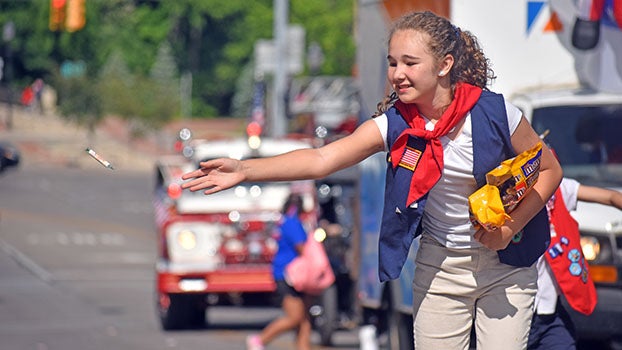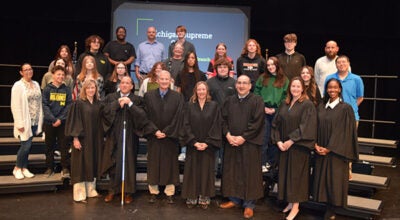Larry Crandall plays St. Andrews for his 60th; his caddy, Simon, says, ‘Oh, laddy, that’s not good’
Published 9:54 pm Thursday, July 15, 2010

Golf coach Van Johnson and Larry Crandall's wife, Jody, were his guests for Thursday's Dowagiac Rotary Club program on their trip to Scotland in June 2009. (The Daily News/John Eby)
By JOHN EBY
Dowagiac Daily News
Few Rotary programs are as timely as Larry Crandall’s Thursday, hours after the 150th British Open – or The Open, as everyone but Americans call it – got underway in St. Andrews, Scotland, at 4 a.m.
“St. Andrews is the host course. The Open rotates between five or six different venues in Scotland and the U.K. (United Kingdom) and a couple of times it has also been in Ireland.
“Today marks the 150th anniversary, making it the oldest professional golf tournament in all of the world. Carnoustie is a little bit north of St. Andrews. It has been dubbed by most of the pros who play all of The Opens as the most difficult of the courses. We played that one and two others, including The Old Course.”
Growing up in Bangor in Van Buren County, Crandall first became interested in golf at 8, tagging along behind his grandfather.
At 12, he began playing regularly with his Palmer pals – Doug and Barry, not Arnold.
The two closest courses were 15 miles away in Paw Paw or 17 miles, north of South Haven.
Both charged $1.25 to play all day.
A parent would drop them off with sack lunches and the boys would get in 36 holes every outing and hunt for lost balls in their spare time.
That’s how “I began my love affair with golf,” Crandall said Thursday noon at Elks Lodge 889.
“Then, another good thing happened. I was in college, dating Jody, and her father called her into his office one summer and told her to bring her checkbook. She obliged.”
Her father directed his daughter to write him a check for, if memory serves, $150.
She complied, to which he explained, “I just bought you some golf clubs, because if you’re going to marry Larry Crandall, you better learn how to play golf!”
“Golf became a family affair,” said Crandall, who started his sons at about 5.
Today’s junior clubs didn’t exist, so he improvised with sawed-off lady sticks and a training grip which forces the golfer to handle the club correctly.
“They both continued to love the game, fortunately,” and they didn’t develop their dad’s bad habits, so soon eclipsed him.
The Crandalls have played two of the four courses where major tournaments are being played this year, including Pebble Beach (site of the U.S. Open) when Jordan was 10 and Justin was 14. They have not played the PGA course in Wisconsin or Augusta, Ga., home of The Masters.
As a 60th birthday present, Justin and Jordan flew Larry and Jody to London for an unforgettable golf getaway as an honorary three-day member.
“In 2008, I received a phone call from Justin, who at that time was living in London with his wife and baby and working over there,” Larry recalled. “Justin took care of the airlines and Jordan took care of the golf,” since he works for Titleist.
Crandall said they used the capital, Edinburgh, a city of 500,000, as “home base.”
Carnoustie is 40 minutes north of St. Andrews, which is 90 minutes from Edinburgh, a picturesque old city with a military castle.
Though The Links of Carnoustie and St. Andrews connotes rolling terrain, with few trees, “Don’t let that deceive you. That does not mean the courses are not difficult,” Crandall says of a picture of an undulating lunar surface if the moon was carpeted with puttable green grass.
Carnoustie’s 18th hole “is considered the toughest finishing hole of all of The Open courses,” he said. “St. Andrews is the birthplace of golf. The original land was donated by King David of Scotland to the citizens of St. Andrews in 1123 to be used for recreation. It wasn’t until 300 years later that they began thinking about golf. You can still see markers out there that they used to mark the golf course and farmland next to it for their sheep and cattle.”
A vice president Jordan works with at Titleist belongs to the R&A, or Royal and Ancient Golf Club, which men must enter wearing sport coats and neckties.
They were able to get on The New Course, new being a relative term, because Jubilee dates to 1895, but that is brand-new compared to The Old Course of 1574.
“There are actually eight courses in St. Andrews,” Crandall explains. “The R&A overlooks the 18th green and the first tee. If you’re watching The Open between today through Sunday, this is a backdrop you’ll see a lot of ” because the formidable stone structure looks like a parliament.
“We teed off at 7 a.m. Saturday (June 12, 2009),” he said.
It costs $300 to play The Old Course – $200 for greens fees and $100 for the caddy.
However, he noted, that’s less expensive than Pebble Beach in California at $495, plus you must stay overnight in the lodge to get a tee time – at least $500 – and no rain checks unless you’re called off the course due to lightning.”
After their first meeting with the concierge they weren’t sure they would be allowed to play St. Andrews, which stipulates a certified handicap of 10 or less.
“You have to submit your name into the ballot box no later than 2 o’clock the prior day. You can do it online or call on the phone, but they have a drawing. You may or may not have your name drawn to play, so you take whatever tee time you get. As honorary members, for three days it was wide open to us – the locker room, the dining room is open from 11 a.m. to 2 p.m. It’s like a museum of golf.”
Holes six and 14 feature “double greens,” Crandall recalled.
“Huge green with two pins. If you hit to the wrong (cup), you’re still on the green with a putt of about three miles.”
Particularly at St. Andrews, there are “pot bunkers,” including the six-foot-deep trap Jack Nicklaus named the Hell Bunker, its imposing wall made of stacked sod.
Seventeen, the “infamous” Road Hole, for The Open has been lengthened about 45 yards to a 295 par-four.
The tee, backed up to the driving range, involves firing over part of the hotel where the roof is 30 feet tall.
His caddy directed him to aim between the O and the D in “Old” in an Old Course sign. But instead of hooking left, Crandall sliced right.
Larry’s caddy was named Simon, as in Simon says, “Oh, Laddy, that’s not good.”
Whether it’s luck, as the J-bros. call it, or skill, as Larry prefers, when his ball hit the hotel or bounced off a bridge, it caromed.
“We heard the clank of it hitting the hotel,” Crandall cringed, but after driving a provisional ball, it turned out his first shot bounced back onto the fairway.
Jordan’s ball landed on the road.
“His drives ‘Wal-Mart’ me,” Crandall explains, as in, “Did you hear? They’re putting in a new Wal-Mart between my drive and yours?”
“Local rules are, if your ball’s on the road, you can take a penalty stroke and move it or play it with no penalty.” The road he compared to Cass County roads’ tar and gravel base before the final blacktop coat.
“Jordan chose to play it – we have it on video. His caddy, Phil or Steve, said when he bounced it up on the green two to three feet from the hole that it was the best Road Hole shot he’d seen in 30 years of caddying.”
Another photo shows them atop Swilcan Bridge, though absent the gallery Arnold Palmer waved to during his final tournament.
What Americans call rough in Scotland amounts to bristly gorse; heather, where you might fight your ball; and burn, the creek water flowing under the bridge
“I hit it in the burn on the 17th hole at Carnoustie, I should have hit it in there the second time on 18. My second shot headed for it. My ball hit the bridge, went over the burn and landed in the trap by the green. I shot 92 at St. Andrews, 85 at Carnoustie and 86 on the Jubilee. Jordan shot 74 (two over par) on St. Andrews and Justin (wearing a Detroit Tigers cap) shot 79.”
Not only is St. Andrews open to the public. the course closes Sundays so the community can stroll the course.
Pedestrians are so prevalent going to the beach that there are fairway signs: “Danger. Golf in progress. Look before crossing. When safe, please cross quickly.”
Of course, no such once-in-a-lifetime golf experience would be complete without toasting it at the ultimate 19th hole, close-by Dunvegan Pub.
“I know a woman 26 years ago who played nine holes of The Old Course and walked off,” offered Rotarian Chuck Ringland. “It was 90 degrees,” retorted his wife, Ann, who added to Crandall’s narrative that women were not allowed in the R&A.
“The R&A is not connected with St. Andrews,” Crandall clarified. “There are about 2,400 members worldwide. They are the governing body for all golf, with the exception of the United States and Mexico. They establish all the rules, they make determinations on club requirements and basically oversee all of golf.”
“The handicap restriction is new,” Chuck said. “Otherwise, I wouldn’t have gotten in.”






